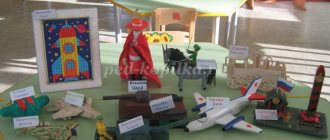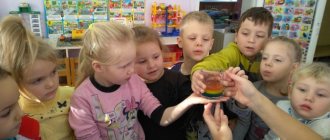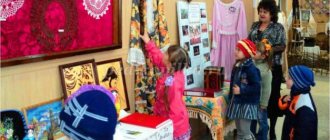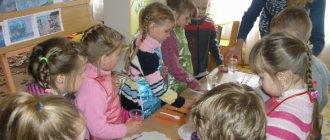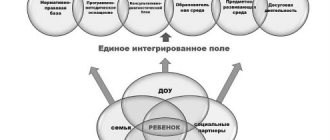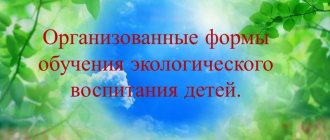Description of work experience “Experimental activities in preschool educational institutions”
Olga Kostrikova
Description of work experience “Experimental activities in preschool educational institutions”
My name is Kostrikova Olga Vitalievna! research with children . I took advanced training courses in this area. Participated in the regional pedagogical conference of preschool educational institutions employees , where she presented her work experience in the form of a presentation . Received a diploma for the best presentation of experience at the Kansk pedagogical conference of the eastern educational district of the Krasnoyarsk Territory “Modern practices of preschool education at the stage of implementation of the federal state educational standard”, Presented at the regional methodological association master class on speech development using elements of experimental activities . Many times she gave open classes for teachers in the region and city.
Currently, the latest developments , technologies, and methods are being formed and successfully applied in the preschool education system, which make it possible to raise the level of preschool education to a higher and higher quality level. One of such effective methods of understanding the patterns and phenomena of the surrounding world is experimental research activities . Children love to experiment . This is explained by the fact that they are characterized by visual-effective and visual-figurative thinking. Therefore, experimental research activity , like no other method, satisfies age characteristics. In preschool age, experimentation is the leading one , and in the first three years it is practically the only way to understand the world.
experimentation method contributes to the formation of integrative qualities of a preschooler. Ensures the integration of educational areas: “Cognitive development”
,
“Social and communicative development”
,
“Speech development”
,
“Artistic and aesthetic development”
,
“Physical development”
.
Develops the child’s interest in the world around him, activity, initiative and independence in his knowledge in the course of practical activities .
Developing a child’s research abilities is one of the most important tasks of modern education. Knowledge obtained as a result of one’s own experiment and research search is much stronger and more reliable for a child than information about the world that is obtained through reproductive means.
The main advantage of experimental research activities is that it is close to preschoolers (preschoolers are natural researchers, and gives children real ideas about the various aspects of the object being studied, about its relationships with other environmental objects.
During the experiment in addition to the development of cognitive activity , there is a development of mental processes - enrichment of memory, speech, activation of thinking, mental skills, since the need constantly arises to perform operations of analysis and synthesis, comparison and classification, the need to give an account of what was seen, to formulate discovered patterns and conclusions ; Not only does the child become familiar with new facts, but also the accumulation of a fund of mental techniques and operations.
Requirements for the modernization of education - the search for new effective forms of teaching preschoolers. In paragraph 4.6. The Federal State Educational Standards target guidelines say that it is necessary to develop in children initiative and independence in cognitive and research activities . In practice, this is carried out through the ability of children to independently perceive simple and complex experiments and draw conclusions. In the children's research laboratory, children can independently reproduce simple and more complex experiments .
I believe that in search and research activities, a preschooler gets the opportunity to directly satisfy his inherent curiosity and organize his ideas about the world. Therefore, I strive to teach not everything, but the main thing, not the sum of facts, but their holistic understanding, not so much to give the maximum information, but to teach how to navigate its flow. I want children to be attracted to experiments not only by the spectacle (changes in color, shape of liquid), but also by an understanding of how to apply this in life.
base my work on children's experimentation on the following ideas :
- a general focus on obtaining new information about a particular object, phenomenon, substance (what new we learned today by conducting experiments with air )
;
- obtaining new knowledge and information, something new, unexpected (Did you like learning the properties of air? Do you want to explore these properties further);
- accumulation of generalized research methods and methods (now you know that air is lighter than water and how this can be checked)
.
When analyzing the activity , I emphasized what has already been achieved and what needs to be strived for, namely, the children learned to analyze, draw conclusions, and can themselves explain some patterns in nature. They conduct experiments and create the conditions for conducting experiments and observations . They are responsible for doing homework. a lot of experimental activities with the children of my group, but there is still something to strive for, that is, I want the children to be able to independently:
- identify and pose a problem that needs to be resolved;
— offer possible solutions;
— test these possible solutions based on data;
— draw conclusions in accordance with the results of the inspection;
- make generalizations.
As part of the implementation of the main educational program of the preschool educational institution, in the educational field of “cognitive development”
,
the work is aimed at achieving the program goal, developing cognitive and research activities . Obtaining positive results in children’s mastery of cognitive-research activities is due to taking into account the age and individual characteristics of preschoolers and the gradual complication of program material (if in the younger group we introduce children to general methods of studying various objects and include children in practical cognitive activities jointly with adults, then in the senior preschool age, we consolidate the ability to use generalized methods of examining objects and develop the ability to determine an algorithm of activity ).
In my research work , I give preference to experiments , experiments , research activities, and independent search activities of children . I see that this type of activity delights children. Experience is fun and exciting, but at the same time, in each experience the cause of the observed phenomenon is revealed, children are led to judgment, conclusion, their knowledge about the properties and qualities of objects, about their changes is clarified. I carry them out both in educational activities and in free independent and joint activities .
Children with great pleasure conduct experiments with objects of inanimate nature: sand, clay, magnets, fabrics, snow, water, air. For example, in order to find out if there is air around us, I suggest children catch it with the help of bags, and then determine what color it is? Having collected air into bags, the children argue that it can be caught, which means it is around us and that it has no color. This is how I introduce children to the properties of air.
From experiment , when water and syrup interact, we learned about its ability to change color, the “Magic Mitten” experiment
helped to find out the ability of a magnet to attract metal objects through a mitten.
Such experiments somehow remind the kids of magic tricks, they are unusual, and most importantly, the kids do everything themselves. Our relationships with children are built on the basis of partnership. Children learn to set goals, solve problems, put forward hypotheses and test them empirically , and draw conclusions. They experience great joy, surprise and even delight from their small and big “discoveries”
which give them a feeling of satisfaction from
the work .
talk endlessly about the experiments and discoveries of young students. I have been convinced in practice that experimental activity is , along with play, the leading activity of a preschool child . The main thing is that the child’s interest in research and discoveries does not fade over time.
Perhaps in the near future, from "Know-It-Yourself"
and
“Whychek”
, graduates of my group will grow up and become outstanding scientists. At school, many children are already excellent students and athletes who defend the honor of the school and the region.
With the introduction of the Federal State Educational Standard, I am paying great attention to working with parents. Cooperation presupposes not only mutual actions, but also mutual understanding, mutual respect and trust. Active joint work helps strengthen relationships between all participants in the educational process. I consider the main tasks in interaction with parents to be:
— firstly, to establish partnerships with the family of each pupil and join efforts for the development and upbringing of children;
- secondly, create an atmosphere of community of interests;
- thirdly, to activate and enrich the educational skills of parents.
Parents take an active part in the “ Experiments at Home ”
,
"Why is that?"
help in equipping and replenishing our group’s laboratory with the necessary materials.
In individual conversations, consultations at parent meetings, and through various types of visual propaganda, I convince parents of the need for daily attention to children's experimentation . Conducted a parent meeting on the topic “Children’s
experimentation in kindergarten and at home” , a survey of parents in order to identify their attitude towards the search and research activity of children
The group has an information corner for parents on research activities . In it, parents can get advice on the topic: “Organizing children’s experimentation at home ,” booklets and recommendations: “Conducting experiments at home ”
, read the memo
“
Experimenting with water ” .
My group has created a laboratory for experimental activities in which we conduct research.
Indoor “Merry Garden”
, where together with children we grow and watch how plants grow and develop.
“Seabed” piggy banks have been collected
,
"What's Under Our Feet"
;
• Instruments – assistants for experimentation : scales, magnets, magnifying glasses, hourglasses;
•Natural materials: sand, clay, earth, seeds, pebbles of different colors and shapes, minerals, clay, earth of different compositions, coal, salt, shells, cones, nut shells, pieces of tree bark, fruit and vegetable seeds.
•Medical materials: pipettes, flasks, syringes, measuring spoons, cotton wool, bandages, test tubes, spatulas, wooden sticks, beakers, funnels, rubber bulbs of various sizes.
• Waste material: plastic, pieces of fabric, leather, fur, foam rubber, test tubes, wire,
•Transparent and opaque vessels of different configurations and different volumes:
plastic bottles, glasses, buckets, funnels.
Additional equipment and materials.
- children's robes, aprons, mantles, robes;
— schemes for conducting experiments .
The laboratory is constantly updated with new materials for experimentation , which are in a place accessible to children.
Children grow up very quickly, they can easily adapt in a social environment, they can find the right solutions on their own if we help their abilities and talents develop today. Let's awaken interest in ourselves and the world around us.
And as V. A. Sukhomlinsky said, “Always leave something unsaid so that the child wants to return to what he learned again and again.”
Practical part
Element of one of the types of experimental activities
Now I want to introduce you to an element of one of the types of experimental activities , the experience of fabric dyeing . I present to your attention a video letter
Experiment “Fabric and paints”
— Take the hoop with the fabric, three markers together in one hand and place dots on the fabric, hold until counting 3 (counting 1, 2, 3.)
.
Like this. (Teacher shows)
.
- I will show you the next action first, and then you.
-I take a syringe, tilt the fabric, and drop a few drops onto each point.
“And now you are doing the same, listening to me.” Take a syringe, tilt the cloth, and drop a few drops onto each point.
- What did you do? (The dots spread and colored the fabric)
— What happened to the dots?
- Why do you think this happened?
— The liquid dissolved the paint of the markers, just as water dissolves watercolors.
What did your dots look like?
Conclusion
The coloring of the fabric occurs from the interaction of the liquid with the marker. Fabrics are dyed with special dyes, and today we learned about an unusual way of applying a design to fabric.
- Look what a wonderful drawing each of you turned out.
And here’s what our guys came up with (showing sample drawings)
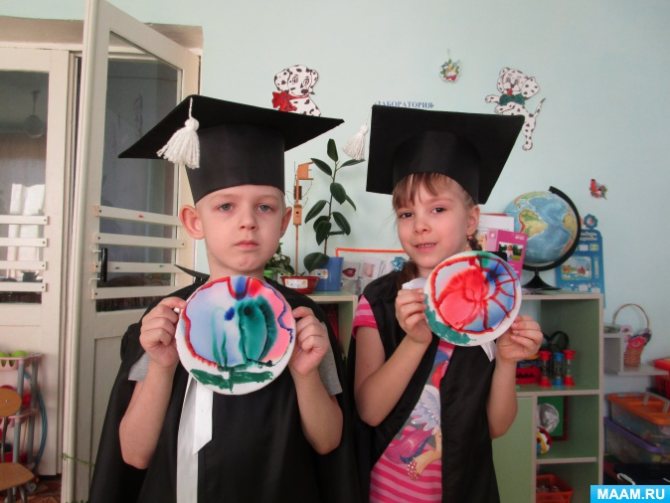
-If you look closely, what does it look like what you got? (children's answers)
You can use markers to complete your drawing.
Currently, we are witnessing how another effective method of understanding the patterns and phenomena of the surrounding world is being formed in the preschool education system - the method of experimentation.
The word “experiment” comes from Greek and is translated as “test, experience.”
The “Modern Dictionary of Foreign Words” contains the following definition:
An experiment is: “a scientifically staged experiment, observation of the phenomenon being studied under scientifically taken into account conditions, allowing one to monitor the progress of the phenomenon and reproduce it many times when these conditions are repeated”; “generally an experience, an attempt to accomplish something.” “An experiment is a systematic observation. Thus, a person creates the possibility of observations, on the basis of which his knowledge about the patterns in the observed phenomenon is formed” (“Brief Philosophical Encyclopedia” 1994). “An experiment is a sensory-objective activity in science; in a narrower sense of the word - experience, reproduction of the object of knowledge, testing of hypotheses, etc.”
From the above definitions it is clear that in the narrow sense of the word the terms “experience” and “experiment” are synonymous: “The concept of experience essentially coincides with the category of practice, in particular, experiment, observation” (TSB, 1974).
So, like most words in the Russian language, “experimentation” is a polysemantic word. It acts as a teaching method if it is used to transfer new knowledge to children. It can be considered as a form of organization of the pedagogical process, if the latter is based on the method of experimentation. Experimentation is one of the types of cognitive activity of children and adults, as can be seen from the definitions given above.
Since the patterns of experiments carried out by adults and children do not largely coincide, the phrase “children’s experimentation” is used in relation to preschool institutions. The development of the theoretical foundations of the method of children's experimentation in preschool institutions is carried out by professor, academician of the Academy of Creative Pedagogy and the Russian Academy of Education N. N. Poddyakov. His many years of research into this activity gave rise to the formulation of the following basic principles:
1. Children's experimentation is a special form of search activity, in which the processes of goal formation, the emergence and development of new personal motives that underlie the self-movement and self-development of preschoolers are most clearly expressed.
2. In children's experimentation, children's own activity most powerfully manifests itself, aimed at obtaining new information, new knowledge (cognitive form of experimentation), at obtaining products of children's creativity - new buildings, drawings, fairy tales, etc. (a productive form of experimentation).
3. Children's experimentation is the core of any process of children's creativity.
4. In children's experimentation, the mental processes of differentiation and integration interact most organically with the overall dominance of integration processes.
5. The activity of experimentation, taken in all its completeness and universality, is a universal way of functioning of the psyche.
The main advantage of using the experimentation method in kindergarten is that during the experiment:
- children get real ideas about the various aspects of the object being studied, about its relationships with other objects and with the environment, about the world of living and inanimate nature.
— The child’s memory is enriched, his thought processes are activated, as the need constantly arises to perform operations of analysis and synthesis, comparison and classification, and generalization.
— The child’s speech develops, as he needs to give an account of what he saw, formulate discovered patterns and conclusions.
— There is an accumulation of a fund of mental techniques and operations that are considered as mental skills.
—Children’s experimentation is also important for the formation of independence, the ability to transform any objects or phenomena to achieve a certain result.
— In the process of experimental activities, the child’s emotional sphere and creative abilities develop, work skills are formed, and health is improved by increasing the overall level of physical activity.
Children's love for experimental activities is explained by the fact that they are characterized by visual-effective and visual-figurative thinking, and experimentation, like no other method, corresponds to these age-related characteristics. In preschool age, it is the leader, and in the first three years it is practically the only way to understand the world.
The initial form of experimentation, according to L.S. Vygotsky, from which all the others developed, is the only form of experimentation accessible to a child - manipulation of objects, which arises at an early age. In the process of manipulating objects, a natural history and social experiment takes place. Over the next two to three years, manipulating objects and people becomes more difficult.
The child increasingly performs investigative actions, assimilating information about the objective properties of objects and people he encounters. At this time, the formation of individual fragments of experimental activity takes place, not yet connected with each other into any kind of system. After three years, their integration gradually begins.
The child moves into the next period - curiosity, which, provided the child is raised correctly, goes into the period of curiosity (after 5 years). It was during this period that experimental activity acquired typical features; now experimentation became an independent type of activity.
A child of senior preschool age acquires the ability to experiment. He acquires the following series of skills in this activity: the ability to see and identify a problem, accept and set a goal, solve problems, analyze an object or phenomenon, highlight essential features and connections, compare various facts, put forward hypotheses and assumptions, select tools and materials for independent activity, carry out an experiment, draw conclusions, record stages of action and results graphically.
The formation and development of these skills requires systematic and purposeful work of the teacher, aimed at developing children’s experimentation activities.
The most important feature of the experiment is that in the process of its implementation the child acquires the ability to control this or that phenomenon: to cause or stop it; change this phenomenon in one direction or another. Experimentation is a special way of spiritually and practically mastering reality, aimed at creating conditions in which objects most clearly reveal their essence, hidden in ordinary situations.
Like any activity, experimentation has its own structure.
Goals and objectives of experimentation:
1. To form in children a cognitive interest in nature, to develop observation and mental activity.
2. Lead children to judgments and conclusions, teach them to draw simple conclusions, and establish cause-and-effect relationships.
3. To promote the preschooler’s perception of a holistic picture of the world and the foundations of his cultural knowledge of the world around him.
4. Motive: cognitive needs, cognitive interest, which are based on the orienting reflex “What is this?”, “What is this?”. In older preschool age, cognitive interest has the following direction: “Find out - learn - know”
5. Means: language, speech, search actions.
6.Forms: elementary search activities, experiments, experiences.
7.Conditions: gradual complication, organization of conditions for independent and educational activities, use of problem situations.
8. Result: experience of independent activity, research work, new knowledge and skills that make up a whole range of mental new formations. [20]
Classification of experiments:
By the nature of the objects used in the experiment: with plants; with animals; with objects of inanimate nature; the object of which is a person.
At the location of the experiments: in a group room; Location on; In the woods.
By the number of children: individual, group, collective.
The reason for their implementation: random, planned, in response to a child’s question.
By the nature of inclusion in the pedagogical process: episodic (conducted from case to case), systematic.
By duration: short-term (5-15 minutes), long-term (over 15 minutes).
By the number of observations of the same object: single, multiple, or cyclic.
By place in the cycle: primary, repeated, final, final.
By the nature of mental operations: ascertaining (allowing one to see one state of an object or one phenomenon without connection with other objects and phenomena); comparative (allowing you to see the dynamics of a process or note changes in the state of an object); generalizing (experiments in which the general patterns of a process previously studied at individual stages are traced).
According to the nature of children’s cognitive activity: illustrative (children know everything, and the experiment only confirms familiar facts), search (children do not know in advance what the result will be), solving experimental problems.
By method of application: demonstration, frontal.
Each type of experimentation has its own methodology, its pros and cons. The development of any child’s activity does not occur by itself, but under the guidance of an adult. In a modern preschool educational institution, the role of the teacher in experimentation is leading at any age. The teacher is directly involved in the experiment in such a way as to be an equal partner for the children, to direct the experiment so that the children retain a sense of independent discovery. Preparation for conducting experiments begins with the teacher identifying current didactic tasks. An object that meets the requirements is then selected. The teacher gets to know him in advance - both in practice and from literature. At the same time, he masters the technique of experimentation, if it is unfamiliar to him.
In the process of experimentation, there is no strict time regulation and it is possible to vary the pre-planned plan, since children’s suggestions and assumptions are unpredictable. The duration of the experiment is determined by the characteristics of the phenomenon being studied and the availability of free time, and the condition of the children, their attitude to this type of activity.
Inviting children to carry out an experiment, the teacher tells them the goal or problem that must be solved, gives them time to think, and then involves the children in discussing the methodology and progress of the experiment. It is undesirable to predict the end result in advance: children lose the valuable sense of pioneering. While working, you should not demand perfect silence from children: when working with passion, they should be relaxed.
The teacher must constantly stimulate children's curiosity, be prepared for children's questions, not impart knowledge in a ready-made form, but help answer the child's question to obtain it independently, through a little experiment. It is advisable to check all the children’s proposals, to allow them, in practice, to be convinced of the correctness or incorrectness of their assumptions (of course, if this does not harm anyone - neither the object of observation, nor the child). During the work, the teacher encourages children to look for their own ways to solve a problem, varying the course of the experiment and experimental actions. At the same time, he does not let out of his sight those who work slowly, for some reason fall behind and lose the main idea.
The final stage of the experiment is summing up the results and drawing conclusions. When formulating conclusions, it is necessary to stimulate the development of children's speech by asking questions that are non-repetitive in content and require a detailed answer from children. When analyzing and recording the results obtained, it must be remembered that an unintended result is not incorrect.
After the experiment, children must tidy up their workspace on their own - clean and hide equipment, wipe tables, remove trash and wash their hands with soap.
With proper organization of work, older children develop a strong habit of asking questions and looking for answers on their own. Now the initiative to conduct experiments passes into the hands of children. They must constantly turn to the teacher with requests: “Let’s do this...”, “Let’s see what happens if...”. The role of the educator as an intelligent friend and adviser increases. He does not impose his advice and recommendations, but waits for the child, having tried different options, to seek help himself. And even then he doesn’t immediately give a ready-made answer, but tries to awaken the children’s independent thoughts and, with the help of leading questions, direct their reasoning in the right direction. However, this style of behavior will only be effective if children have already developed a taste for experimentation and a culture of work has been formed.
In the preparatory group, conducting experiments should become the norm. They should be considered not as an end in themselves and not as entertainment, but as the most successful way of introducing children to the world around them and the most effective way of developing thought processes. Experiments make it possible to combine all types of activities and all aspects of education. The initiative to carry them out is distributed evenly between the teacher and the children.
You must always remember to follow safety rules. For example, all unfamiliar complex procedures are mastered in a certain sequence:
- the teacher shows the action;
- the action is repeated or demonstrated by one of the children, moreover, the one who will obviously perform it incorrectly, which will make it possible to concentrate attention on a typical mistake;
- sometimes the teacher himself deliberately makes a mistake: with the help of such a methodological technique, he gives the children the opportunity to concentrate their attention on a mistake, the likelihood of which is high;
- the action is repeated by the child who will not make a mistake;
- the action is carried out all together at a slow pace so that the teacher has the opportunity to monitor the work of each child;
- the action has become familiar, and the children perform it at a normal pace. When choosing an object, one must take into account its maximum compliance with the goals and objectives solved during the experiment, giving preference to the one in which this characteristic is more clearly expressed.
Thus, in a modern preschool educational institution, children’s experimentation has the following features:
— experimentation is a teaching method if it is used to transfer new knowledge to children;
— experimentation as a specially organized activity contributes to the formation of a holistic picture of the world of a preschool child and the foundations of his cultural knowledge of the world around him;
— experimental work arouses the child’s interest in exploring nature, develops mental operations (analysis, synthesis, classification, generalization, etc.), stimulates the child’s cognitive activity and curiosity, activates the perception of educational material on familiarization with natural phenomena, the basics of mathematical knowledge, ethical rules of life in society, etc.;
- children's experimentation consists of successively replacing each other stages and has its own age-specific developmental characteristics;
- children's experimentation, according to N.N. Poddyakova, claims to be the leading activity during the period of preschool development of the child.
Experimentation as a means of developing cognitive and research skills
This article discusses experimentation as a means of developing cognitive and research skills. The goals and objectives of the experimentation and the results of its application are presented.
Key words: experimentation, development, cognitive and research skills, children, preschoolers.
This article discusses experimentation as a means of developing cognitive-research skills. The goals and objectives of experimentation and the results of its application are presented.
Keywords: experimentation, development, cognitive-research skills, children, preschoolers.
The concept of modernization of modern Russian education reinforces the fact that currently it is necessary to pay full attention to the development of not only deep and lasting knowledge, but also general educational skills, universal competencies, functional literacy and socially significant qualities. This approach requires the formation in educational practice of certain pedagogical conditions for the inclusion of children in active cognitive and research activities, since research seems to be a necessary element in every profession. Therefore, research behavior today is assessed as an integral characteristic of a person, included in the structure of ideas about professionalism in each industry [1, p.23].
The regulatory legal acts of the Russian Federation enshrine the importance of developing children's research activity. For example, the Federal Law “On Education in the Russian Federation” stipulates that preschool education is aimed at developing intellectual qualities and creating the prerequisites for the educational activities of preschool children. In the Federal State Educational Standard for Preschool Education, one of the tasks of the educational field “Cognitive Development” is the need to develop and stimulate the interests of children of senior preschool age, their initiative, curiosity, cognitive motivation, and research activity.
Preschool children are born researchers, as noted in the works of A. N. Leontyev, N. G. Morozova, A. K. Dusavitsky. At this age, curiosity, a constant desire to experiment, and a desire to independently find a solution to a problem situation are very evident. Therefore, the main task of the teacher is not to interfere with such activities, but to actively promote [1, p.24].
Experimental work promotes children's interest in exploring nature, developing mental operations (analysis, synthesis, classification, generalization), activates cognitive activity and curiosity, enlivens the perception of educational material on familiarization with natural phenomena, the basics of mathematical knowledge, and the ethical rules of life in society [2].
In the age group of 1.5–3 years, the richness of the environment is of primary importance for the development of children’s cognitive and research skills. Games with water are of great importance for this age group: “Let’s find out what kind of water”; “Making colored ice floes”; with air: “What’s in the bag?” "Games with straws"; “Games with a balloon and a straw”; "The wind blows across the sea." Games with light, color: “What’s in the box?”; “Magic brush”, with warmth: “Hot - cold”; "Wonderful bag"; games with a person: “Merry little men are playing”; “Let's draw your portrait”; “Let’s fix the toy”; "Our Helpers"; games with paper, its qualities and its properties; wood, its qualities and properties; with fabric, clay and their properties [3, p. 9].
In the fourth year of life, preschool children begin to develop visual-figurative thinking. Children's curiosity clearly manifests itself, they begin to ask adults a large number of questions.
Starting from this period, it is very useful not to provide knowledge in a ready-made form, but to encourage the child to extract answers in the process of experimental activity. In this case, the child’s question turns into a goal formulation. The teacher should think over the methodology for conducting the experiment and implement the necessary actions together with the child. Children of this age are not yet fully able to work independently, but with great desire they do this together with an adult.
While working, you can periodically ask the child to perform not one, but two actions in a row (pour out the water and pour in new). It is advisable to involve them in predicting outcomes by asking questions. Children begin to develop voluntary attention, which facilitates the first attempts to record the results of observations.
In middle age, children show interest in experimenting with water, sand, clay, magnets, light, and sound. The subject content of the experimentation center should contain: magnifying glasses, large and small; water containers; containers with sand; pebbles floating and sinking; air balloons; molds with lids; sticks of different lengths; threads, wires; metal containers; pumps. With children, you can organize observations of living nature, plants, animals, as living organisms, growth, needs, reproduction, characteristic features of the seasons, conduct experiments in inanimate nature, water, games with sand, clay, stones, games with light, color, person.
In the senior group, long-term experiments are carried out, during which general patterns of phenomena and processes are established. The increased complexity of experiments and the independence of children require more strict adherence to safety rules [4, p. 34].
Thus, the objectives of experimentation as a means of developing cognitive and research skills are:
1. Educational objectives:
- enrich knowledge about living and inanimate nature, demonstrate their interrelation;
- in a short time establish a suitable answer to the question facing him;
teach problem solving;
- consolidate knowledge about the properties of air, water, magnet, soap.
2. Developmental:
develop the ability to analyze and draw conclusions, engage in cognitive communication;
- develop curiosity, memory, logical thinking, creative imagination, and the ability to fantasize;
develop active speech skills, enrich active vocabulary
- promote the development of cognitive interests;
- develop skills in conducting experiments.
3. Educational:
teach methods of independent knowledge through creative experimental activities;
continue to cultivate a love for nature and respect for it;
develop the ability to listen to a friend’s opinion and not interrupt;
- cultivate interest in experimentation, show patience and perseverance.
Experimentation allows you to achieve the following results.
For preschoolers:
expanding the prospects for search and cognitive activity;
development of initial skills of environmentally literate and safe behavior in nature and at home;
- development of initiative, intelligence, and independence in children.
For teachers:
increasing theoretical experience and professionalism;
introduction of modern forms and methods of work on experimental activities of preschoolers;
personal and professional growth;
- self-realization.
For parents:
increasing the level of environmental awareness;
expanding the experience of interaction with children [5].
In conclusion, it is worth noting that experimentation as a special type of work aimed at cognition and transformation of objects of the surrounding reality, promotes the development of cognitive and research skills in preschoolers and implies an active search for a solution to a problem, putting forward hypotheses, implementing this assumption and drawing conclusions at an accessible level for a given age. Experimentation is considered as a source of comprehension of the surrounding reality, during which the preschooler expresses himself as the face of the activity, without the help of others, building and expressing research activity in it. The advantages of experimentation are determined by the fact that it gives children the opportunity to develop an idea of the various facets of the object under study, its relationships with other objects and the direct environment of its existence and functioning. Experimentation attracts the child as a process that provides conditions for the manifestation of independence, the possibility of realizing plans, creating a situation of choice and changing existing things through one’s own actions and efforts, thereby ensuring the discovery of something new. Research activity is valuable in the formation of a child, as it gives them the right not only to master knowledge, but also to extract it through their experience. Taking into account the fact that preschool age is a sensitive stage in the formation of children’s personality, research activity will be the new formation that will later become the basis for the student’s educational activities.
Thus, experimentation can be defined as an activity of an active transformative nature that contributes to the development of cognitive and research skills.
Literature:
- Khandeeva R. A. Experimentation as a means of developing cognitive and research skills // Reviewers: Rano Alymbekovna Kutanova, Ph.D. ped. Sciences, Associate Professor, Head. — 2022. — pp. 23–26.
- Experimentation as a means of developing children’s cognitive abilities [Electronic resource]. — URL: https://infourok.ru/doklad-iz-opita-raboti-eksperimentirovaniekak-sredstvo-razvitiya-poznavatelnih-sposobnostey-detey-2189759.html (access date: 05/17/2020).
- Dybina O.V., Rakhmanova N.P., Shchetinina V.V. The unknown is nearby. Experiences and experiments for preschoolers. M.: Sfera, 2022 - P.192.
- Popova A. N. et al. Experimentation as a means of developing search and research activities in preschoolers // Education: past, present and future. — 2016. — pp. 32–35.
- Experimental research activity as a method of cognitive development of a preschool child [Electronic resource]. — URL: https://www.maam.ru/detskijsad/yeksperimentalno-isledovatelskaja-dejatelnost-kak-metod-poznavatelnogo-razvitija-doshkolnika-857289.html (access date: 05/21/2020).
